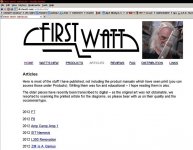Mr. Pass: Please check post #58 in the Thread by wrenchone entitled " L'Fake .." for detailed. I showed in it the schematic [attached below] of a working amp which used your underlined teaching above. Worked beautifully; a winning approach.You can build this circuit with just about anything, and that is the point of
such a topology. The Jfets I used are nice parts, but not the central thing.
The central thing to me was a nice passive way of isolating and splitting the
drive for the devices while at the same time implementing feedback, all done
passively by the transformer.
Sits will work fine, as will ordinary Mosfets.

Brgds.
Attachments
What if the amp described in the schematic of the above post is a diy F6 [its output stage, and the transformer is Jensen]? Since F6 does not invert the overall phase of the input signal, then the phase symbol on the primary winding [of my schematic] will need to be reversed. Thus one defaults to the signal phase in F6. Except, the loop feedback topology I implemented in my schematic is different from that practiced by lhquam, buzzforb, generg and others in their diy F6.Mr. Pass: Please check post #58 in the Thread by wrenchone entitled " L'Fake .." for detailed. I showed in it the schematic [attached below] of a working amp which used your underlined teaching above. Worked beautifully; a winning approach.
Brgds.
I have also used a non-inverting TCA as a working amp with a simultaneous correction for phase at the primary of the transformer to be like the posted schematic of F6. It worked as well as the phase inverting amp above.
The question is not will it work; but rather how will this modified diy F6 sound with your loudspeakers? Clearly you have the flexibility to lower or increase Vf [in my schematic].
Last edited:
I need to add one detail about the Full Range drivers which I used in my study. This low cost driver [~$100] is a 15 inch Aluminum Cone Musical Instrument Speaker [40 Hz -7 KHz]. It is un-enclosed, and is securely bolted to a ceiling joist. Call it if you wish a No-Baffle situation. Both R and L drivers are angled inward, and focus their output at the listening sweet spot on the floor.
I can only imagine the sound with other [pricier] FR drivers like Fostex, Lowther and others.
I can only imagine the sound with other [pricier] FR drivers like Fostex, Lowther and others.
Mr. Pass: Please check post #58 in the Thread by wrenchone entitled " L'Fake .." for detailed. I showed in it the schematic [attached below] of a working amp which used your underlined teaching above. Worked beautifully; a winning approach.
Brgds.
I have seen it, as you should recall.
F6
I have my F6 running. The sound is between the F3 and the F5, leaning towards the F3 in the upper registers and the F5 in the bottom end.
I had to use two red LED's to get enough bias for the SemiSouth R100's. I'm also running my rails at 30 volts so I added a 1.2K in the drain of the front end FETs to burn off a few volts. I have it in my Aleph, F5, now F6 Chassis and the power supply has remained the same. I did add an additional RC on the board with a 22KuF and .22 ohms just to be able to check the bias without raising the hood on the rest of the supply.

I have my F6 running. The sound is between the F3 and the F5, leaning towards the F3 in the upper registers and the F5 in the bottom end.
I had to use two red LED's to get enough bias for the SemiSouth R100's. I'm also running my rails at 30 volts so I added a 1.2K in the drain of the front end FETs to burn off a few volts. I have it in my Aleph, F5, now F6 Chassis and the power supply has remained the same. I did add an additional RC on the board with a 22KuF and .22 ohms just to be able to check the bias without raising the hood on the rest of the supply.
An externally hosted image should be here but it was not working when we last tested it.
I'm also running my rails at 30 volts so I added a 1.2K in the drain of the front end FETs to burn off a few volts.
i do not see any decoupling caps after the 1.2k
i do not see any decoupling caps after the 1.2k
You are correct, I did not add any. I will try it and see if it makes a difference in the sound.
Normally, they are needed, or Jfet drains voltages will move with signal.
Why not cascoding?
Just lazy, I had the F5 cascoded.
What planet are you from?
I have some r100s' from the original group buy waiting for this, should I be storing them with the leads up or down don't want them to go bad. Is there a blue book out on these things yet?
Bill
I have my F6 running. The sound is between the F3 and the F5, leaning towards the F3 in the upper registers and the F5 in the bottom end.
I had to use two red LED's to get enough bias for the SemiSouth....

That is a good description of the F6 sound!
I took the blue LEDs Nelson mentioned in the BAF lesson, the deliver around 2,8V, so you need only one per side and of course....
You have the "blue"sound Nelson intended, only with these one...
NOT to speak of the green ones, some well known Greenhorn uses every day in myrads ....impossible!
- Home
- Amplifiers
- Pass Labs
- F6 Amplifier


